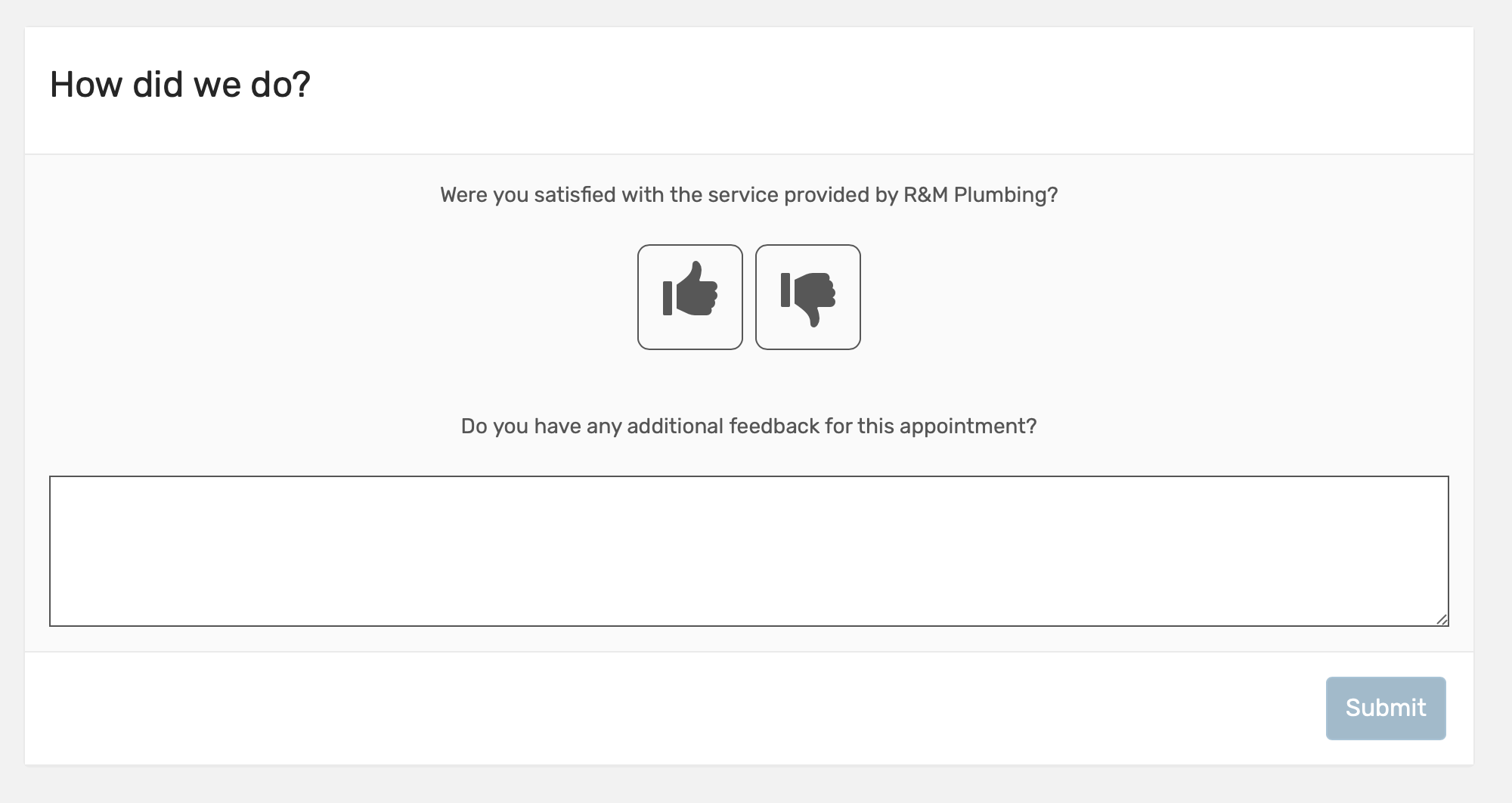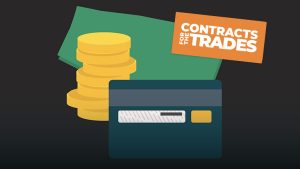5 Best Practices for Using Customer Feedback Software
November 23, 2022 | Read: 14 minutes

If you want to make collecting feedback easy, then customer feedback software can help.
With a digital tool, you can work faster to increase your understanding of how customers experience your services.
With greater awareness, you can go on to deliver positive experiences, boost satisfaction, and even attract new customers!

What is customer feedback software?
Customer feedback software makes it for you to capture reviews, ratings, specific feedback, and more. Through the use of custom-made questionnaires, forms, and prompts, your engineers and staff can use software to collect feedback whether they’re in the field, home, or the office.
It’s that easy.
Customisable software can also be set up to help your team send emails automatically, immediately after a job is completed. With software making communication faster and more convenient, fantastic feedback loops will help you to improve your services and positively shape future customer experiences.
Retain your customers and give them outstanding service by utilising customer feedback software in the best way possible.
“86% of buyers are willing to pay more for a great customer experience.”
superoffice.com
1. Brainstorm survey goals and questions
Before asking questions it’s important to think about the result you want. What’s the goal of the form? What information do you want to find out?
You don’t want to be clueless about how customers see your services. Instead, you can use a survey to get your biggest questions answered.
Oftentimes, those questions boil down to the following: was my service successful or unsuccessful?
With this goal in mind, draft a survey that helps you understand whether or not you met your customer’s needs for that job.
Decide what questions to ask:
Make a decision on the general format of the survey. Most respondents prefer simple multiple-choice surveys and aren’t as keen on answering questions that require mandatory written responses.
Select your questions wisely. Ask yourself: what is it that I really need to know to optimise my business?
Write a list of information that would help you move your business forward. From there, write questions.
Select the strongest question or questions. The less time-consuming the survey, the better.
Use incentives when necessary:
There are a few different incentives you may want to consider.
Most directly, explain how submitting a survey provides useful information, which will help you provide a better customer experience for customers like them.
This type of intrinsic reward encourages your customers to engage in behaviour that benefits both parties. This may help you get more survey takers who are serious about providing valuable feedback.
If you wish, you can use extrinsic rewards. However, these can be less effective because some people are only doing the survey to obtain a prize, gift, or discount. If that’s their primary motivation, they may not give the most accurate or quality data.
2. Write questions with your audience in mind
Even in the digital world, human interaction is more important than ever. So, as your phrase your questions, make them sound like natural questions.
You’re far more likely to engage customers with genuine sounding questions.
“Worldwide, an average of 75% of customers, say they want more human interaction in the future, even as technology continues to improve,” and in addition “46% of consumers say that they will abandon a brand if the employees are not knowledgeable.”
The CX Lead
Making sure you’re having human interactions then and demonstrating value, can make a significant impact. One surprisingly simple approach to this is to structure a survey with a simple thumbs up/thumbs down approach, or by using smiley faces.
It may sound simplistic, but it’s an accessible, clear distinction that’s easy to understand how a customer views the overall experience they had. If you want more detail, then you can follow-up with specific questions later.
The thumbs up/thumbs down or emoji method is great because it adds a human element to your survey, giving customers something familiar to work with. Thumbs come off as more friendly than numbers, which feel more clinical.
When it comes to questions, making them sound conversational can help get customers talking.
When writing questions, it’s a good idea to read them out loud to see how they sound. Is the phrasing natural or wooden? Try them out on colleagues, as well, in practice, to see whether they agree if your language sounds conversational.
Don’t forget: Collecting verbal feedback is still an option, so long as accurate notes are added after the conversation; that’s something a field service engineer app on mobile can make easy!
Alternatively, with your software, you might choose to add a text box underneath the icons that customers can select. This gives them a choice to provide extra information without making them feel obligated to do so.
After all, if someone has an opinion, they’ll want it to be heard, and making it easy for them to share their thoughts in a variety of ways can be a big help.

Personalise your survey request:
Email is an excellent way to send your survey across, as we’ll go into more detail later on.
With your email, it’s key to personalise, personalise, personalise! Studies show that addressing the customer by name increases response rates.
The first way to personalise is by using tagging to customise the form. With your software, you can write emails that use tags that will convert into the respective words.
By writing “Dear [customer-name]”, your software automatically inputs the customer name when your email sends.

Here’s how the email could look while you’re still drafting in your software:
Use a smart subject line:
Which subject line do you think is more effective at getting customers to open your email?
A. “Take our short customer satisfaction survey!”
B. “Thank you for choosing R&M Plumbing!”
If you thought “a” is most effective, it’s actually “b” that’s most likely to engage the reader. Ironically, using the word “survey” in your subject line makes people less likely to open: it feels like an obligation.
Instead, focusing your subject line with gratitude tends to make people feel appreciated. It’s important to motivate them to open your emails and, within the email itself, they’ll see your request for feedback.

3. Design an appealing survey with customer feedback software
Surveys aren’t everyone’s idea of a fun time, but this is where a bit of creativity comes in handy.
As mentioned, images and emojis are an easy way to grab attention, but great customer feedback software can help you to be more creative. These surveys can boost engagement and encourage participation.
Make the survey visually engaging:
A customer is much more likely to give something their attention if that thing is pleasant to look at.
Forms and questionnaires often look dull, so it helps to change things up!
You don’t have to go crazy with lots of colours and images. In fact, it’s simple, clear designs that help keep people’s attention.
Use bold text, simple colours, don’t crowd the page with questions and you’ll lead your audience through a simple yet engaging survey that’s easy to complete.
Keep the form short and sweet:
To go in line with this, it’s important to aim for a short, straightforward survey. If your goal is to simply find out if a customer’s experience was positive or negative overall, you don’t need to ask too many questions.
In this case, we’d advise that you make a survey one page long, with no more than 3-5 questions. If you can get what you need in a couple of questions, even better!
Remember: you are much more likely to get feedback when you keep it brief.
You wouldn’t want to spend your valuable time making a survey no one completes and your customers don’t want to spend an hour answering one, either. Long surveys are all too easy to dismiss right away and get ignored.
Your chances of getting a response increase if you make your survey as short as possible and make it clear you aren’t about to take up their time. Be clear and direct. You could even suggest a time limit:
“We have a survey we’d love for you to answer, it’ll only take a few minutes of your time!”
After all, complicated surveys are a major turn-off and participating in the feedback process is voluntary, so make it easy on them. The lengthier the survey is, the less likely it is that you’ll get a response.
4. Choose the best time to send a survey
Invite them to fill out the form via email or text
Send a form to their email or via text message to notify them of your survey request.

You want your email to offer easy participation.
On the plus side, sending your survey online already makes it easily accessible. In the email, include the survey portal link so they can easily navigate to your brief survey.
You can also choose to send your survey via text message. With this approach, you benefit from sending your survey to a device that most people carry almost all of the time.
If you’re going to text route, make sure your message is still professional.
Casual texts may be okay among your social circle, but you want it to read similarly to an email when you’re texting for business purposes.
Send the email right after you raise the final invoice
As mentioned earlier, you can use customer feedback software to automatically send a feedback request to a customer after a job is completed. This could also be set up once the final invoice is raised.
By using an after-sales care portal—a digital link to a webpage—right after the invoice is raised, you can grab their attention when your service work is still fresh in their mind.
5. Take action soon after sending feedback
Follow up with customers to encourage a survey response if they didn’t fill it out the first time.
If they don’t fill the survey out the first time, keep trying!
“Following up increases your chances of a response by 58%. In general, sending up to three reminders gets you the best results.”
Survey Any Place
It’s recommended that you reach out 3-7 days after the initial invitation.
“If you’re concerned people will get upset for sending them a reminder survey, we’ve found that only 0.5% will actually unsubscribe.”
Survey Any Place
There are various moves you can make with sending follow-up requests.
Most importantly, try to add extra or different value to each follow-up. You also will want to switch a few things up with your messaging for each new request.
For example: you could try a different subject line or use different language in the email. To reinforce their participation, you can remind them of the reason why these results help improve the services you provide to them.
At the end of the day, you usually don’t know for sure why someone didn’t fill out your survey the first time around. They could have a crowded email inbox and miss many emails, could have deliberately decided not to, or whatever else in between.
Or, maybe you just caught them at the wrong time. By following up, you increase the chances of receiving invaluable feedback.
Analyse aggregate results with customer feedback software:
If you don’t analyse the results, it’s almost pointless that both you and customers spent time on a survey.
Your job management of choice should have reporting software showing customer satisfaction data. This provides a general idea of how happy survey respondents are with your services.
The closer you are to 100%, the more positive ratings you are receiving in comparison to negative reviews.
If you’re getting great reviews, you can highlight this with a stat on your website.

Analyse individual jobs and take action:
It’s critical to look at the individual cases to understand specifics about what’s working and what’s not.
In their “Future of CX” report, PwC surveyed 15,000 consumers and found that 1 in 3 customers will leave a brand they love after just one bad experience.
To provide the best possible customer journey, take your feedback as a chance to learn what’s succeeding and what could use improvement. Maybe there is a certain technician or service that has been performing well, you want to continue that good work!
Let the technician know they’re getting great reviews and you could try marketing that particular service more.
You can even state that the technician/service is “highly reviewed”:

Alternatively, you may notice a pattern with certain services or technicians not performing as well, and now’s the time to address that head-on:

To combat this feedback, you should have meetings and problem-solve how to improve the jobs to best meet customer needs. Adjust procedures or give some extra help to particular technicians if you notice any patterns.
Always follow up with respondents:
It can be extremely helpful to follow up with both positive and negative reviews. Use this as an opportunity to apply what you learned from analysing your results.
With positive reviews, this is the perfect opportunity to ask satisfied customers for referrals and prompt them to share a public review. These are powerful tools to help you attract new customers to your service.
It’s no secret that people look at the best reviews before they trust your technicians to come into your home. In other words, public reviews fuel your business growth.
When it comes to reviews that lean negative, you can do a couple of things when reaching out. If you are unclear on their feedback and what went wrong, you can ask for a few more details.
If there was an error or a job that didn’t work out well, now’s a good time to apologise and commit to doing better next time.
You can even say what you will do to ensure the problem doesn’t occur again or offer a discount on future services. Do your best to mend the relationship and be there for them in the future.
Beware of bias:
While customer feedback software is extremely useful to help you know where you stand, the results should be taken with a grain of salt. The feedback is not always objective and 100% representative of how successful or unsuccessful the service was.
Variance exists with survey results for a variety of reasons. You can’t control all the variables and something that isn’t directly related to your service may have contributed to their negative or positive review.
People may answer in a certain way based on their demographic or lifestyle or based on how their day is going, for example. Some people tend to be more optimistic and others more pessimistic, so those personality traits may influence their selections.
In most cases, you won’t get a response for each and every survey you send out. Those who have an extreme opinion about your services tend to have the most motivation to provide feedback. They want their opinion to be heard.
So, this means that you could be missing out on a chunk of data and aren’t getting a representative sample for your aggregate data.
Discover Customer Journeys with Commusoft:
Customer feedback shines a light on where you stand with customers and using software makes it easier than ever to get the insight necessary to improve your services.
By using these best practices and getting to grips with simple but effective feedback requests, you’ll be able to craft, analyse, and learn more about your customer, your services, and grow with confidence.
We can help.
At Commusoft, we’re dedicated to helping installation, service, and maintenance businesses take their customers on world-class journeys. It’s why we’ve crafted customer service tools designed to help.
For a detailed look at how we can help you, explore our guide on how to write emails that ask for reviews!












